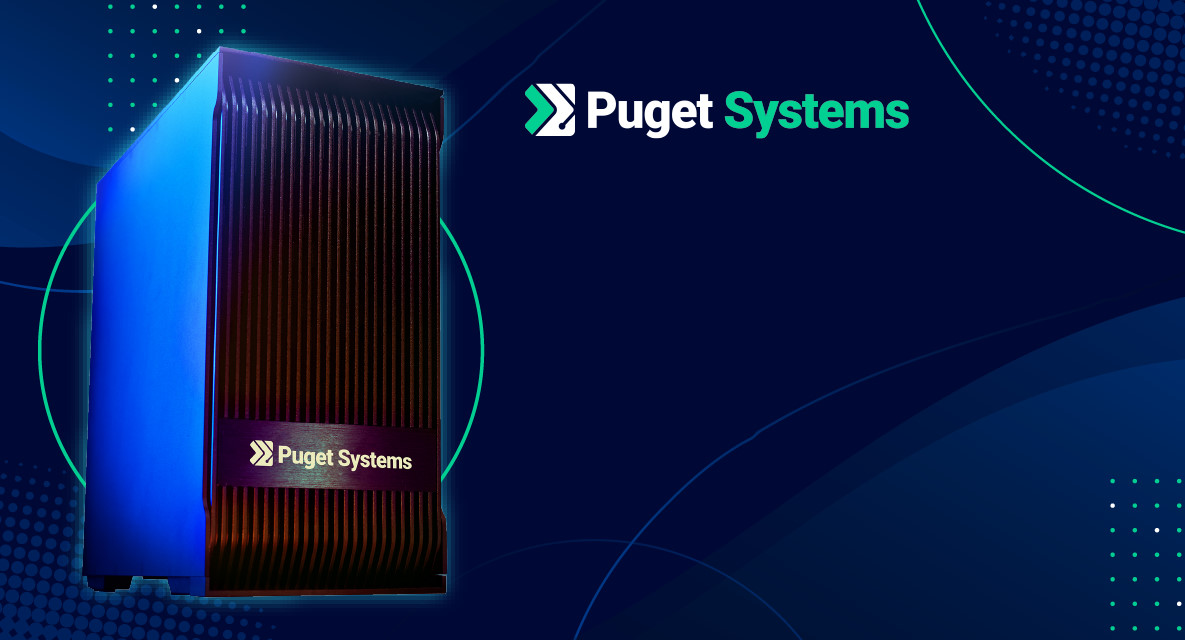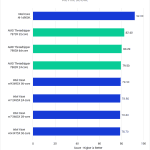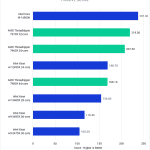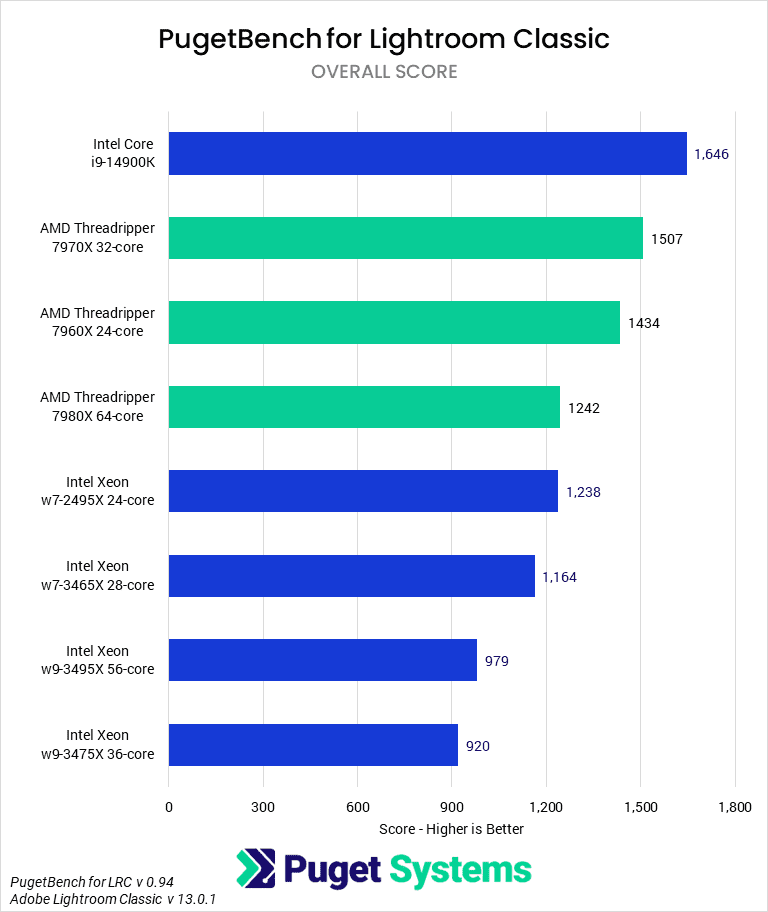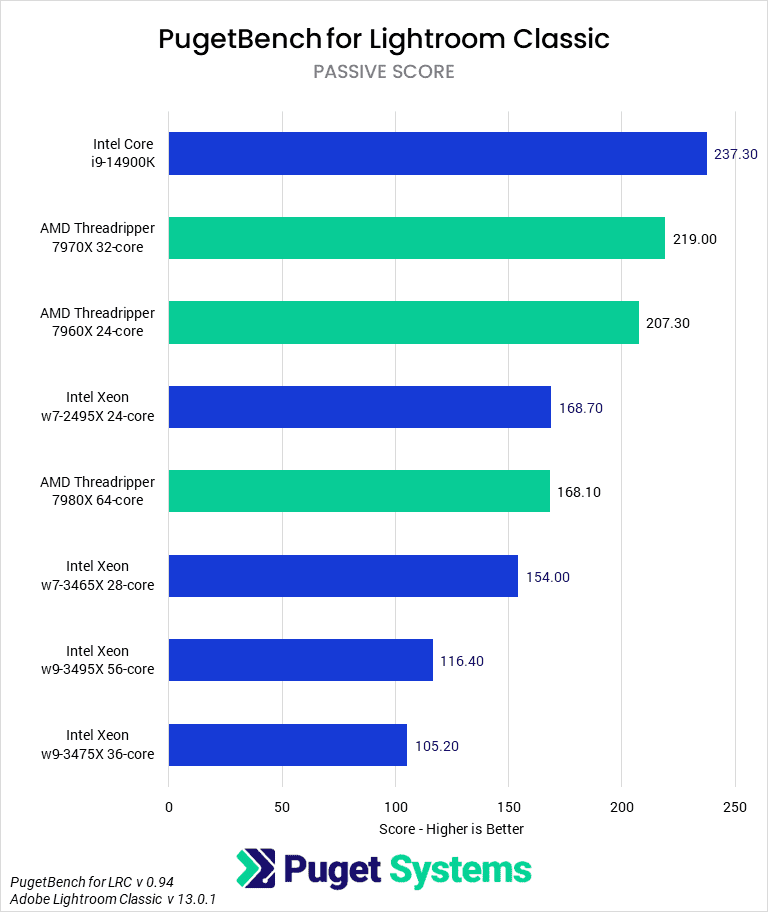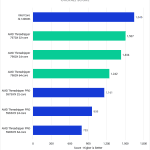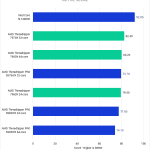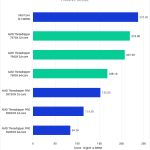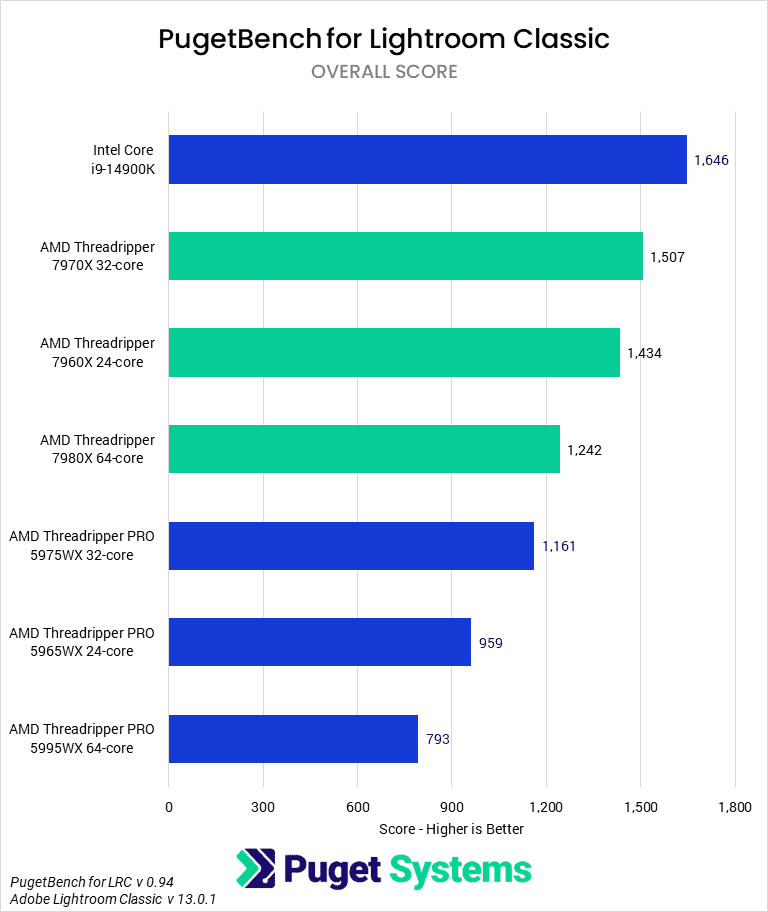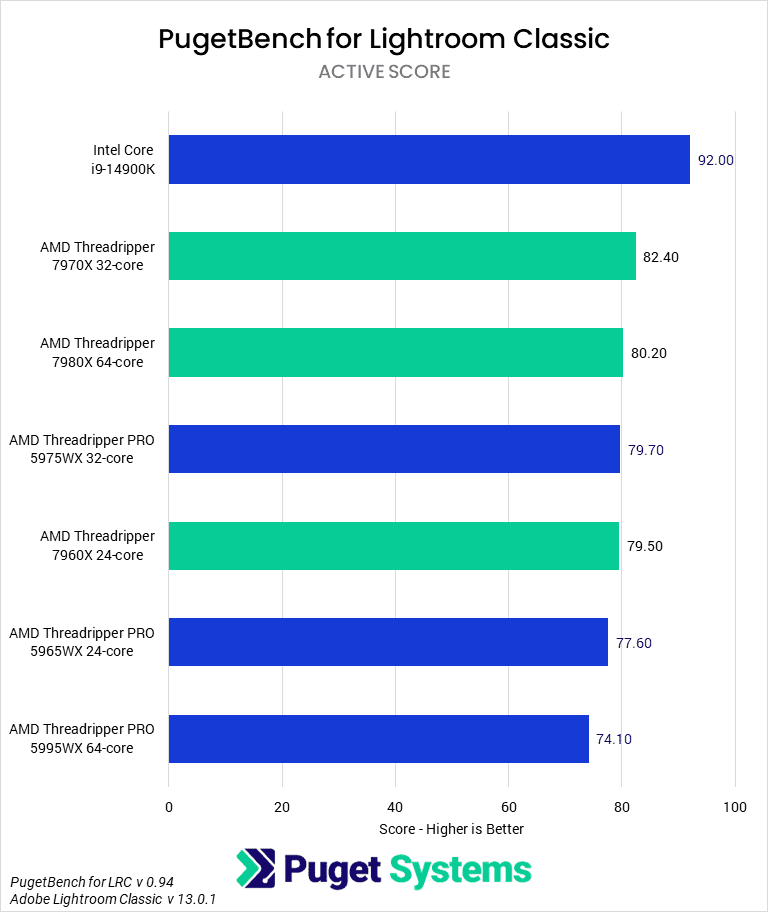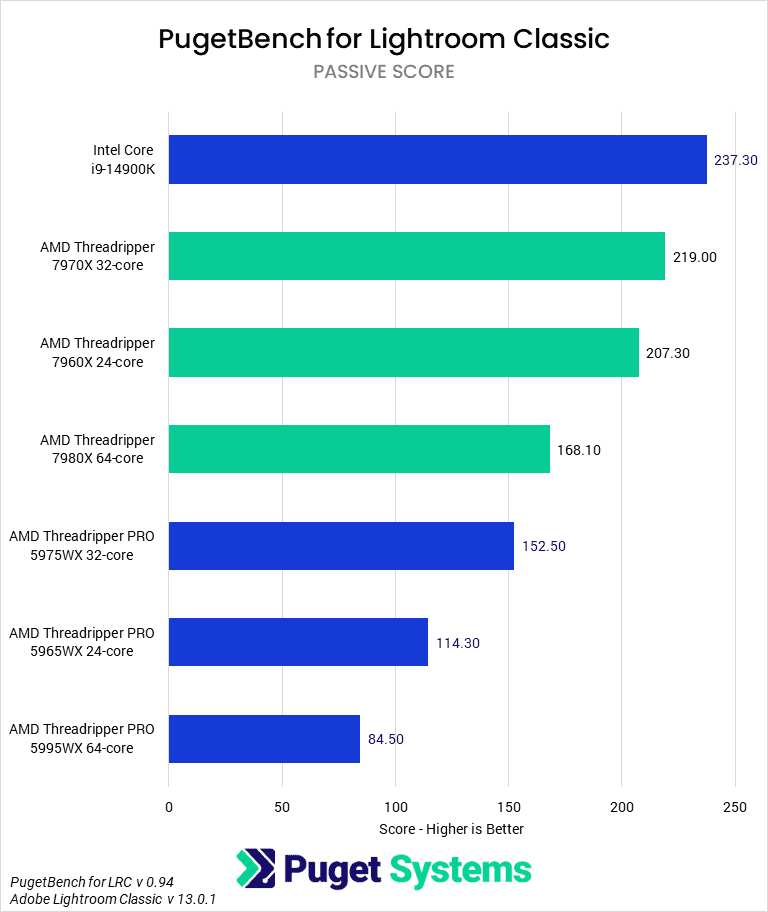Table of Contents
TL;DR: AMD Threadripper 7000 Performance in Lightroom Classic
While a more affordable CPU like an Intel Core i9-14900K will give you better performance in Lightroom Classic than Threadripper or Xeon, the new 7000-series processors close the gap significantly. Where the previous generation Threadripper PRO 5000 WX-series was at best nearly 40% slower than a 14900K, the new Threadripper 7970X in particular is within 10%. That is a small enough difference that it would be hard to notice unless you are looking for it, which will help with workflows that combine Lightroom Classic with heavier workloads like photogrammetry.
For those workflows, the new Threadripper 7000 processors are particularly good for passive tasks like importing and exporting photos where they are anywhere from 45% to 2x faster than the previous generation. Active tasks like scrolling through images and switching modules, however, are about on par with the previous generation.
Compared to the Intel Xeon W processors, passive tasks are again where most of the performance advantage is found, with around 25% to 60% more performance compared to similarly priced Intel Xeon W processors. This means that, overall, we are looking at about a 15-35% performance lead for AMD Threadripper 7000 over Intel Xeon W-2400/3400.
Introduction
AMD recently announced the new Threadripper and Threadripper PRO CPUs, once again splitting their high core-count CPUs into two separate product families: the High-End Desktop (HEDT) AMD Ryzen Threadripper 7000 Series, and the even higher tier AMD Ryzen Threadripper PRO 7000 WX-Series processors. Both are based on AMD’s Zen 4 architecture, which is currently powering their Ryzen 7000 line of desktop processors, as well as the Genoa, Genoa X, and Bergamo EPYC server processors. This upgrade in architecture means they now support new technologies like PCI-e Gen 5.0 and DDR5 memory, but we also expect increased per-core performance, which should help quite a bit in applications like Lightroom Classic.
Today, we will focus on the performance of the Threadripper 7000 Series (non-PRO) compared to the previous generation Threadripper PRO 5000WX and the Intel Xeon W-2400/3400 line. In our last Intel Xeon W-3400 review, we found that the Threadripper PRO 5000 Series CPUs traded blows with the new Xeon chips, so we suspect that the new Threadrippers will be able to propel AMD in front. It is worth noting that these Threadripper CPUs have fewer memory channels and PCI-E lanes than the previous generation Threadripper PRO CPUs or Intel Xeon W-3400 line, but neither of those is very impactful for Lightroom Classic. In addition to Threadripper PRO and Xeon, we will also include the Intel Core 14900K to provide some context for how AMD Threadripper compares to a more typical CPU choice for this type of workload.
Because there are so many CPUs to examine, we will break our analysis down into Intel vs AMD (AMD Threadripper 7000 vs Intel Xeon W-3400) and performance versus the previous generation (AMD Threadripper 7000 vs AMD Threadripper PRO 5000)
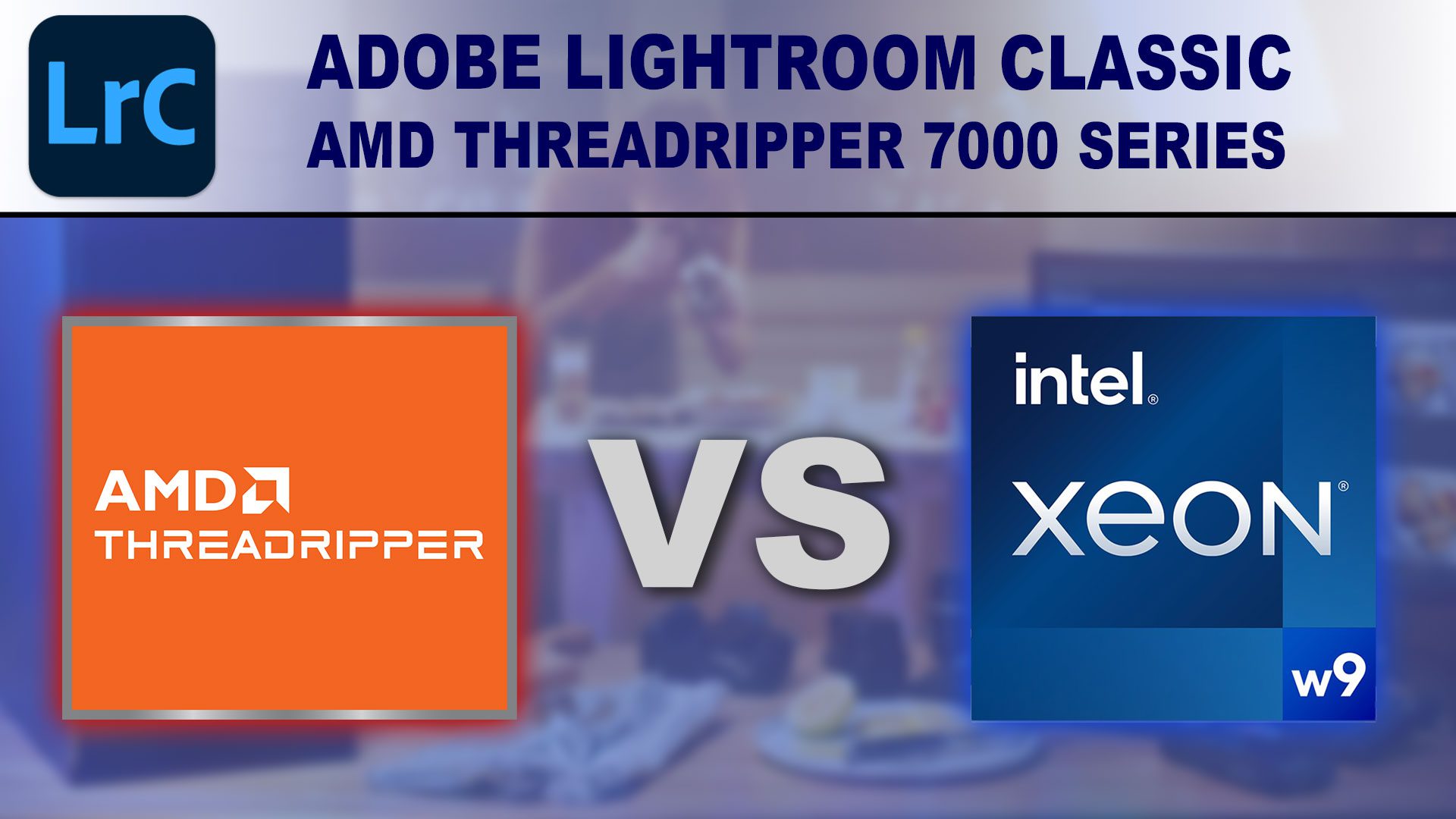
To learn more about how the new AMD Ryzen Threadripper 7000 Series processors perform in other workflows, we have compiled an overview in our AMD Ryzen Threadripper 7000 Content Creation Review article. That post also includes more detailed information on the CPU specifications and test results for various applications: Photoshop, Premiere Pro, DaVinci Resolve, After Effects, Unreal Engine, Cinema 4D, Blender, and V-Ray.
In addition, although all the new AMD CPUs have a TDP of 350 W, TDP is rarely the whole story. To see how much power these chips use to complete tasks, check out our Power Analysis: AMD Ryzen Threadripper 7000 article.
Raw Benchmark Data
We design our benchmarks to cover a variety of workflows and tasks to provide a balanced look at the application and its hardware interactions. However, many users have more specialized workflows. Recognizing this, we like to provide individual results for benchmarks as well. If there is a specific area that comprises most of your work, examining those results will give a more accurate understanding of the performance disparities between components.
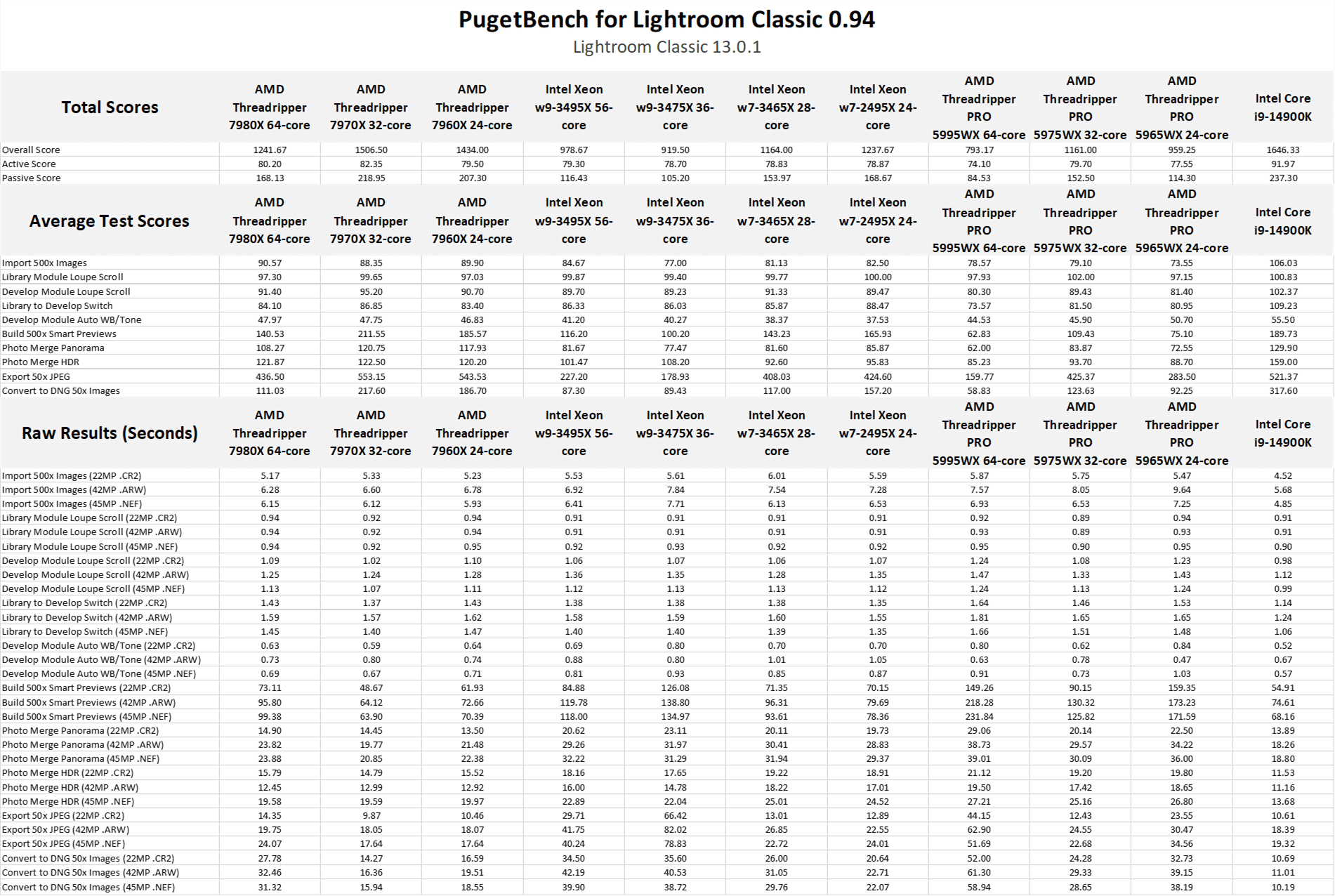
AMD Threadripper 7000 vs Intel Xeon W-3400 for Adobe Lightroom Classic
Lightroom Classic is interesting as the way it utilizes the hardware in your system is very different depending on the type of task. Our benchmark breaks down the tests into two groups: active and passive. Active tests (chart #2) look at things like switching modules, scrolling through images, and other tasks that individually take a short amount of time, but that you do hundreds or thousands of times a day. These tasks are typically lightly threaded, and performance is largely based on the per-core performance of your CPU. Because of this, you tend not to see much of a difference between CPUs of the same family.
On the other hand, passive tasks (chart #3) like importing, exporting, and generating previews are moderately threaded and can utilize CPUs with more cores – at least to a certain point. Lightroom Classic tends to start having issues when you have more than 32 cores (or, more accurately, 64 threads) due to how Windows divides a processor into multiple logical processor groups. Unless the application is programmed to consider these, it can result in a heavy performance penalty for very high-core count CPUs.
Even with the higher multi-core performance for passive tasks, you will probably notice that the Intel Core i9 14900K is faster than any of the Threadripper or Xeon CPUs we tested. This is not a mistake – like many other lightly/moderately threaded applications, CPUs like Intel Core and AMD Ryzen are simply a better fit and can give you more performance at a significantly lower cost. Still, there are many use cases where a Lightroom Classic user may take that performance hit to get better performance in other aspects of their workflow. For example, this is a common situation for those who do both photography and photogrammetry.
With that explained, let’s start by looking at the new Threadripper 7960X 24-core. In terms of pricing, this CPU is less expensive than the Intel Xeon w7-2495X 24-core but scored about 16% higher overall. That almost entirely comes from a 23% performance lead for passive tasks, as the results for active tasks across all the Threadripper and Xeon CPUs we tested were within the margin of error.
Moving a step up, the Threadripper 7970X 32-core is priced roughly on par with the Xeon w7-2495X 24-core and came in at about 22% faster overall. Once again, the difference for active tasks is minimal, but it scored roughly 30% higher for passive tasks.
At the very top, the Threadripper 7980X 64-core is a bit of an odd processor for Lightroom Classic as it is slower than either the 24- or 32-core models due to the scaling issues we mentioned earlier. This is not a specific issue with the new Threadripper CPUs and is a fairly common problem that we see on Intel Xeon processors as well. Since Intel has the same problem, this still lets the 7980X be ~30% faster than the Xeon w9-3475X or w9-3495X (which the 7980X is priced right in between), or 45-60% faster for passive tasks in particular. But, again, for Lightroom Classic it is much better to stick to a CPU with 32 or fewer cores so you can get more performance, for less money.
AMD Threadripper 7000 vs AMD Threadripper PRO 5000WX for Adobe Lightroom Classic
Compared to the previous generation, we again have a bit of an issue of direct comparisons not being perfect due to how much less expensive Threadripper 7000 is compared to the previous generation Threadripper PRO 5000WX.
Starting at the lower end, the new Threadripper 7960X 24-core is about $750 less expensive than the Threadripper PRO 5965WX 24-core, but performs about 50% higher. Almost all of that comes from the improved performance for passive tasks (chart #3) like importing and exporting, where it ended up being a massive 80% faster, or nearly twice as fast!
Moving up one level to the Threadripper 7970X 32-core, the closest price comparison is again the Threadripper PRO 5965WX 24-core – especially when you factor in motherboard costs as well as the cost of the CPU itself. With that comparison, the new 7970X is about 57% faster overall, with most of that coming from passive tasks to the tune of a 92% performance increase. If you prefer to compare the 7970X to the same core count from the previous generation, the gen-over-gen performance gain is closer to 30% overall (3% active, and 44% passive), but keep in mind that the 5975WX 32-core is about $650 more expensive (in addition to the higher motherboard cost).
As we explained in the previous section, the 64-core Threadripper 7980X isn’t likely a CPU you would choose for Lightroom Classic, since this application tends to have problems with CPUs that have more than 32 cores. However, it is worth pointing out that the new 7980X doesn’t seem to be impacted nearly as much as the previous generation. The 32-core 7970X will still be faster, but only to the tune of 20-30%. For reference, the previous generation Threadripper PRO 5975WX 32-core was around 50-80% faster than the 64-core 5995WX. Since it appears AMD was able to mitigate Lightroom Classic’s limitations in some ways, that makes the new 7980X about 60% faster than the 5995WX overall, or almost exactly 2x faster for passive tasks.
How Well Do the AMD Threadripper 7000 CPUs Perform in Lightroom Classic?
While the new AMD Threadripper 7000 processors showed some very impressive gen-over-gen performance gains, it is worth pointing out that if performance in Lightroom Classic is your primary concern, an Intel Core or AMD Ryzen CPU is going to give you more performance at a significantly lower price. Even for tasks that can take advantage of multiple cores, that class of CPU is simply a better fit for how Lightroom Classic utilizes hardware.
Still, there are many workflows where you may be using Lightroom Classic alongside other applications that can benefit from the raw horsepower that Threadripper and Xeon CPUs can provide. For those workflows, the new Threadripper 7000 processors are particularly good for passive tasks like importing and exporting photos where they are anywhere from 45% to 2x faster than the previous generation. Active tasks like scrolling through images and switching modules, however, are about on par with the previous generation
Compared to the Intel Xeon W processors, passive tasks are again where most of the performance advantage is found, with around 25% to 60% more performance compared to similarly priced Intel Xeon W processors. This means that, overall, we are looking at about a 15-35% performance lead for AMD Threadripper 7000 over Intel Xeon W-2400/3400.
While a more affordable CPU like an Intel Core i9-14900K will still give you better performance in Lightroom Classic than Threadripper, the new 7000-series processors close the gap significantly. Where the previous generation Threadripper PRO 5000 WX-series was at best nearly 40% slower than a 14900K, the new Threadripper 7970X in particular is within 10%. That is a small enough difference that it would be hard to notice unless you are looking for it, which will help with workflows that combine Lightroom Classic with heavier workloads like photogrammetry.
Every application uniquely utilizes hardware, so our results here don’t necessarily translate to any other application. Our focus in this article centers specifically on Threadripper 7000’s performance in Adobe Lightroom Classic. However, we recommend checking out our AMD Ryzen Threadripper 7000 Content Creation Review article, which includes a broad overview of results for several different applications. If you use other software packages, it also has links to our in-depth testing articles for content creation: Photoshop, Premiere Pro, DaVinci Resolve, After Effects, Unreal Engine, Cinema 4D, Blender, and V-Ray.
Finding the perfect workstation doesn’t have to be complicated. Explore our solutions page for a curated selection of recommended systems for a multitude of applications and workflows, or visit our custom configuration page if you already know the ideal hardware for your needs. If you need assistance with tailoring a system to a unique workflow or have any other questions, we encourage you to reach out to our dedicated technology consultants.

